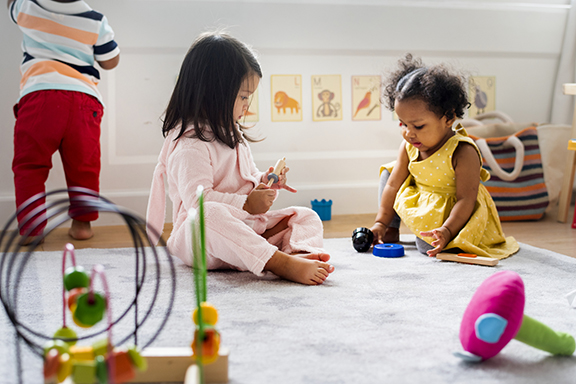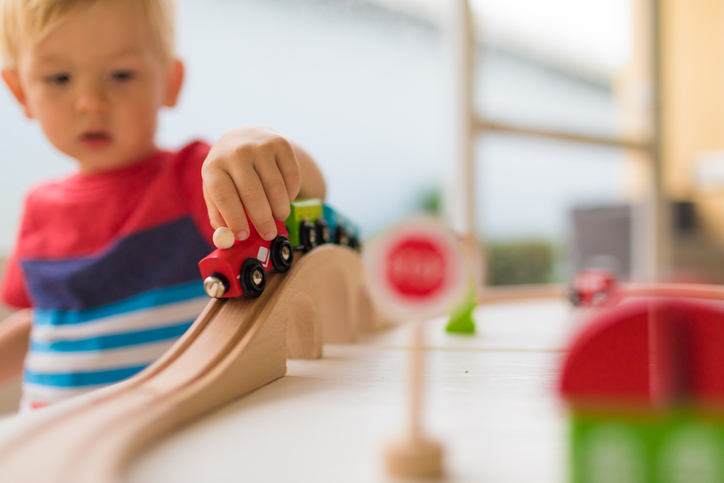How Kids Learn Flexibility and Self-Regulation
Chelsey Rosen, Child Psychologist
One of the most common things parents seek help for is their concern that their child does not know how to be flexible or that they have difficulty self-regulating. Some kids get so anxious during specific activities or outings that they feel they need to stay close to their parents or not go at all. Other kids start screaming and yelling when they do not get something they want, and parents feel they need to give in or the child will be unable to move on. The truth is that many kids have difficulty with self-regulation and it is our job as parents to teach them how.
The strategy I teach the most in practice is the PRIDE skills from Parent-Child Interaction Therapy (PCIT). PCIT is an evidence-based treatment developed in the 1970s by Sheila Eyberg for children with Oppositional Defiant Disorder (ODD) and Attention Deficit Hyperactivity Disorder (ADHD). The treatment consists of two phases, the first called Child-Directed Interaction (CDI), which is child-led, and the second is Parent- Directed Interaction (PDI), which is parent-led (Eyberg & Funderbunk, 2011). The parents are instructed to practice CDI at least five minutes daily. The purpose of teaching CDI first is to have parents focus on strengthening the relationship between parent and child so that when they get to the limit-setting phase (PDI), children are more likely to listen, and the dyad has already established a powerful bond. A study also found that when CDI was introduced first, children were likelier to move on from negative conflict and were less aggressive than those who did not use PRIDE skills first.
Clinicians across the board have found that sometimes by the time we get to PDI, we have already seen much improvement in the child’s behavior. Many children are more likely to listen without parents even having to give commands—they are more flexible and can handle disappointment much better than when they started CDI. We can see a reduction in oppositional behavior and an increase in their ability to attend to a specific task for longer (Hershell et al., 2002). There have been many adaptations for internalizing disorders because many clinicians realize that if we can see these PRIDE skills help children with ODD and ADHD learn to self-regulate, we could use them for all kids, regardless of diagnosis ( Carpenter et al., 2014).
In this article, first, I will go over what PRIDE skills are, and then give some examples of how to use them in practice with your children. These skills will benefit all families and setting aside five minutes of special time with each child is so beneficial. Research shows that five minutes is all it takes, and it is just as important for the parent as it is for the child (Eyberg & Funderbunk, 2011). It is just five minutes of no interruptions, no phone calls, no cooking dinner, and no answering emails for you to be present for yourself and your child.
P—praise (labeled):
Make these specific, saying something such as “I love how you stayed calm even though your tower fell” or “Thank you for being flexible when our plans changed.”
R—reflections:
Paraphrase or repeat what your child says to show them that you are listening to them.
I—imitate:
When playing with your child or doing anything with them, it is helpful to imitate what they are doing so that you are right there with them. They learn that you approve of what they are doing and that they get a chance to take the lead.
D—describe:
Often called play-by-play, this skill is beneficial when your child is anxious and hesitant about doing something or when your child is doing something they do not want to do, creating an unhappy attitude.
E—enjoy:
Especially when playing with our children, we want to show that we are enjoying our time together, which boosts confidence and strengthens relationships.
In addition to using these PRIDE skills, we also want to avoid questions and commands during this time. This way, we are not taking the lead away from the child or adding more pressure.
The first example I will give is a five-year-old girl, Charlie. Charlie loves to play with kids her age and often asks her parents for playdates. Her parents report that she prefers to play one-on-one with kids, but teachers say she will play in a small group at school. Her parents also report that Charlie hates birthday parties and dislikes participating in gym or music at school. They report that she cries when she learns she is attending a birthday party and often refuses to go. When they get her there, she will typically cling to her parents the whole time and she rarely participates, even when her best friends are there. Here is how Charlie’s parents can use the PRIDE skills to help her participate and even enjoy the next birthday party.
First, Charlie’s parents should try getting to the party early. It is much easier for a child to have kids walking in while they are already there than to walk into a crowded room. The parents should use their PRIDE skills throughout the party and do their best to avoid questions and commands. Something like, “I see you’re walking into the room, and there are balls and arts and crafts and even balloons. I love arts and crafts, I am going to go and color with the markers on the table. Thank you for following me.” Once at the table and doing the activity, continue to use the PRIDE skills to help Charlie get comfortable and, in turn, help her learn to self-regulate. This may sound like, “I see you’re using the yellow marker to make a sun. I am also going to draw. I am going to draw the stars to go with your sun. You are doing such a great job playing at the party!” If you noticed, the parents avoided asking her what activity she wanted to do. Avoiding questions and commands, automatically takes the pressure off and invites the child to join you.
The parents should also use the PRIDE skills with other children who join in on the play to keep them engaged as well. Specifically praise them for playing together. The parents’ goal is to take more of a backseat as she continues to play and eventually move out of proximity and stand on the sidelines. After the party, the parents should praise Charlie for being brave and playing with her friends without mom and dad.
The second example is a seven-year-old boy, David. David needs help being flexible and often shuts down if things go differently than planned. If his parents say “no” he often acts aggressively or yells for 15 to 20 minutes. His parents often give in to avoid the tantrum and keep peace at home. This example is a bit different than Charlie’s example because it is not about a specific event but about things that happen multiple times during a typical day, such as when his tower falls as he plays with Magna-Tiles or when his parents say he can’t watch TV until after dinner even though he wants to watch it now.
However, like Charlie, I would recommend that David’s parents practice CDI five minutes each day and when he appears to be dysregulated. First, his parents should use variations of the labeled praises “Thank you for being flexible” and “I love how you stayed calm even though things didn’t go as planned” ALL DAY. Anytime his parents can identify when David was being flexible or calmed himself down quickly, they should point it out. During times he does not get what he wants, such as when his parents say he cannot watch TV until later, his parents should set a clear boundary such as, “I hear that you want to watch TV now, but TV time is after dinner. Now it is time to play with your toys. I see Legos, Magna-Tiles, and books out in your room.” In this statement, the parents let David know they heard him and then let him know exactly what it is he can do.
I often give kids a few options because it can be overwhelming to say, “Play what you want.” When you give children too many options, it makes it harder for them to comply. If David begins to cry and yell, the parents should go over to one of his toys and start narrating their play. Eventually, David will join them because being with his parents is reinforcing. At that time, his parents should praise him for joining them and calming himself down. If the parents cannot join him in play, they should still continue to hold the boundary and implement “active ignoring strategies.”
Active ignoring is very different from ignoring. It is a skill taught when children display attention-seeking behaviors, such as screaming and yelling when they do not get their way. Active ignoring means ignoring behaviors that you want to decrease while focusing on positive behaviors, such as taking a deep breath, calming down, etc. It is extremely important to catch children while they are trying to calm down. If we miss those moments, active ignoring will not be effective (Eyberg & Funderbunk, 2011). The more consistent parents are, the more the child will learn to calm themselves down quicker and quicker each time, leading to greater self-regulation.
Using PRIDE skills can help both kids and adults manage anxiety and stressors of everyday life. The more consistently they are used, the more natural—and accessible—they will become.
References
Carpenter, A. L., Puliafico, A. C., Kurtz, S. M., Pincus, D. B., & Comer, J. S. (2014). Extending parent-child interaction therapy for early childhood internalizing problems: new advances for an overlooked population. Clinical Child and Family Psychology Review, 17(4), 340–356. https://doi.org/10.1007/s10567-014-0172-4.
Eyberg, S. M., & Funderburk, B. (2011). Parent-Child Interaction Therapy Protocol. Gainesville, FL: PCIT International.
Herschell, A. D., Calzada, E. J., Eyberg, S. M., & McNeil, C. B. (2002). Clinical issues in parent-child interaction therapy. Cognitive and Behavioral Practice, 9(1), 16-27.
Dr. Chelsey Rosen is a child psychologist in New York City specializing in work with children, adolescents, and families using therapeutic interventions and cognitive behavioral therapy.
This article appeared in the 2024 issue of the Parents League Review. Get the current issue of the Review free with a family membership. Or purchase it separately.











